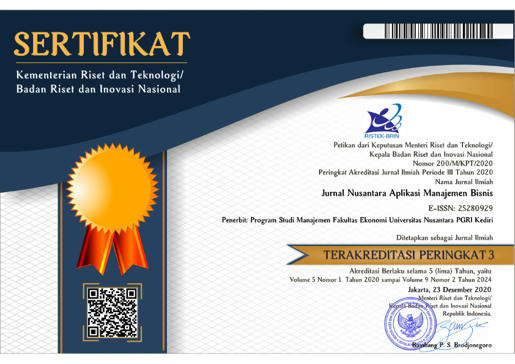INVESTMENT OPPORTUNITY SET, DIVIDEND POLICY AND CORPORATE VALUE: EVIDENCE FROM TRADE, SERVICES AND INVESTMENT SECTOR OF INDONESIA STOCK EXCHANGE
DOI:
https://doi.org/10.29407/nusamba.v4i2.12763Keywords:
Investment Opportunity Set, Dividend Policy and Corporate ValueAbstract
The purpose of this paper is to investigate influences the proxy of investment opportunity set and dividend policy on corporate value. This study is tested with a sample of trade, services and investment sector in Indonesia Stock Exchange which is contained 72 companies covering a 3-years period from 2009 to 2011. Structural equation modeling with Partial Least Square is used in this study. This paper found a significantly positive influence between the proxies of investment opportunity set on dividend policy. In addition, there is a significantly positive influence between the proxies of dividend policy on corporate value. The result had consistently with informational content of dividend that explained that dividend paid was considered to be companies prospect in the future. This result also supported signaling theory that emphasize dividend paid is a signal on the market. The result also revealed a significantly positive influence between the proxies of investment opportunity set on corporate value. This result has supporting and consistently with research result by Fama (1978). Direct effect from investment decision on corporate value is results obtained of investment activity itself.
Downloads
References
Abor, Joshua. and Godfred A Bokpin. (2010). Investment Opportunities, Corporate Finance, and Dividend Payout Policy: Evidence from Emerging Markets. The Journal of Economics and Finance, 27 (3): 180-194.
Al-Malkawi, H.N. (2007). Determinants of Corporate Dividend Policy in Jordan: An Application of the Tobit Model. The Journal of Applied Accounting Research, 23: 44-70.
Al-Najjar, B. and K Hussainey. (2009). The Association Between Dividend Payout and Outside Directorships. The Journal of Applied Accounting Research, 10: 4-19.
Battacharya, S. (1979). Imperfect Information & Dividend Policy and The ‘Bird in Hand’ Fallacy. The Bell Journal of Economics, 10: 259-70.
Battacharya, S. (1997). Dividend Policy: A review. The Journal of Managerial Finance, 1: 4-13.
Belkaoui, Ahmed R. and Ronald D Picur. (2001). Investment Opportunity Set Dependence of Dividend Yield and Price Earnings Ratio. The Journal of Managerial Finance, 27 (3): 65-71.
Black, F. (1976). The Dividend Puzzle. The Journal of Portfolio Management, 2: 5-8.
Brigham, Eugene F., and M.C Ehrhardt. (2005). Financial Management Theory and Practice, 11th
DeAngelo, H., L DeAngelo. and D.J Skinner. (1996). Reversal of Fortune: Dividend Policy and the Disappearance of Sustained Earnings Growth. The Journal of Financial Economics, 40 (3): 341-71.
Easterbrook, F.H. (1984). Two Agency-Cost Explanations of Dividends”. The American Economic Review , 74: 650-9.
Elloum, Fathi. and J.P. Gueyie. (2001). CEO Compensation, IOS and the Role of Corporate Governance”. The Journal of Corporate Governance, 1 (2): 23-34.
Fama, Eugene.F. (1978). The Effects of Firm’s Investment and Financing Decisions on the Welfare of Its Security Holders. The American Economic Review, 68 (3): 272-284.
Fama, Eugene F. and Kenneth R French. (1998). Taxes, Financing Decisions, and Firm Value. The Journal of Finance, 53 (3): 819-843.
Fama, E. and K French. (2001). Disappearing Dividends: Changing Firm Characteristics or Lower Propensity to Pay?. The Journal of Financial Economics , 60: 3-43.
Gaver, Jennifer.J. and Kenneth.M Gaver. (1995). Compensation Policy and The Investment Opportunity Set”. The Journal of Financial Management, 24 (1): 19-32.
Ghozali, Imam. (2006). Structural Equation Modeling: Metode Alternatif dengan partial Least Square. Badan Penerbit UNDIP. Semarang.
Gul F.A. and B.T Kealey. (1999). Chaebol, Investment Opportunity Set and Corporate Debt and Dividend Policies of Korean Companies. Rev. Quant. Finance and Accounting, 13: 401-416.
Hayes, T. (2001). The Research Driven Investor How to use Information Data and Analysis for Investment Success. McGraw Hill. New York. p 305.
Hair, J.F., W.J Black., B.J. Babin, R.F Anderson. and R.L. Tatham. (1995). Multivariate Data Analysis, 6th Edition. Pearson International Edition.
Hair, J.F., C.M. Ringle and M. Sarstedt. (2011). PLS-SEM: Indeed a Silver Bullet. The Journal of Marketing Theory and Practice, 19 (2): 139-151.
Hussainey, Khaled., Chijoke Oscar Mgbame. and Aruoriwo M. C Mgbame. (2011). Dividend Policy and Share Price Volatility: UK Evidence. The Journal of isk Finance, 12 (1):57-68.
International Monetary Fund, World Economic Outlook Update. 2012.
Indonesian Capital Market Directory, Annual Report, Indonesia Stock Exchange 2009.
Indonesian Capital Market Directory, Annual Report, Indonesia Stock Exchange 2010.
Indonesian Capital Market Directory, Annual Report, Indonesia Stock Exchange 2011
Itturiaga, Felix J. Lopes and Juan Antonio Rodrigues Sanz. (2001). Ownership Structure, Corporate Value and Firm Investment: A Simultaneous Equations Analysis of Spanish Companies. The Journal of Management and Governance, 5 (2): 179-204.
Jensen, M.C. and William.H Meckling. 1976. “Theory of the Firm: Managerial Behavior, Agency Cost and Ownership Structure”. The Journal of Financial Economics, 3 (4): 305-360.
Kallapur, S., and M. Trombley. 1999. “The Association Between Investment Opportunity Set Proxies and Realized Growth”. The Journal of Business Finance and Accounting, 26 (3&4): 505-519.
Kallapur, Sanjay. and M.A Trombley. 2001. “The Investment Opportunity Set: Determinants, Consquences, and Measurement”. The Journal of Managerial Finance, 27 (3): 3-15.
Lintner, J. 1956. “The Distribution of Incomes of Corporations among Dividends, Retained Earnings and Taxes”. American Economic Review, 46: 97-113.
Miller, M.H. and F Modigliani. 1961. “Dividend Policy, Growth and the Valuation of Shares”. The Journal of Business , 34: 411-33.
Myeong-Heon Cho. 1998. “Ownership Structure, Investment, and the Corporate Value: An Empirical Analysis”. The Journal of Financial Economics, 47: 103-121.
Myers, S. 1977. “Determinants of Corporate Borrowing”. The Journal of Financial Economics, pp.147-175.
Myers, Stewart.C. and N.S Majluf. 1984. “Corporate Financing and Investment Decisions When Firms Have Information That Investors Do Not Have”. The Journal of Financial Economics, 13:187-221.
Myers, S. 1977. “Determinants of Corporate Borrowing”. The Journal of Financial Economics, 5:147-175.
Nishat, Mohammed and C.M. Irfan. 2003. “Dividend Policy and Stock Price Volatility in Pakistan. Finance, Economic, and Accounting Conference, pp. 1-22.
Ross, Stephen. A. (1977). The Determination of Financial Structure: The Incentive - Signaling Approach. The Bell Journal of Economics, 8 (1): 23-40.
Rozeff, M. (1982). Growth Beta and Agency Cost as Determinants of Dividend Payout Ratios. The Journal of Financial Research, pp. 249-259.
Smith, C.W., Jr. and R.L Watts. (1992). The Investment Opportunity Set and Corporate Financing, Dividends, and Compensation Policies. The Journal of Financial Economics, 32: 262-292.
Subramaniam, R., S.S. Devi, and M Marimuthu. (2011). Investmment Opportunity Set and Dividend Policy in Malaysia. The Journal of Business Management, 5 (24): 10128-10143.
Vogt, Stephen C. (1997). Cash Flow and Capital Spending: Evidence from Capital Expenditure Announcements. The Journal of Financial Management, 26 (2): 44-57.
Downloads
Published
Issue
Section
License
Authors who publish with this journal agree to the following terms:
- Copyright on any article is retained by the author(s).
- The author grants the journal, the right of first publication with the work simultaneously licensed under a Creative Commons Attribution License that allows others to share the work with an acknowledgment of the work’s authorship and initial publication in this journal.
- Authors are able to enter into separate, additional contractual arrangements for the non-exclusive distribution of the journal’s published version of the work (e.g., post it to an institutional repository or publish it in a book), with an acknowledgment of its initial publication in this journal.
- Authors are permitted and encouraged to post their work online (e.g., in institutional repositories or on their website) prior to and during the submission process, as it can lead to productive exchanges, as well as earlier and greater citation of published work.
- The article and any associated published material is distributed under the Creative Commons Attribution-ShareAlike 4.0 International License











